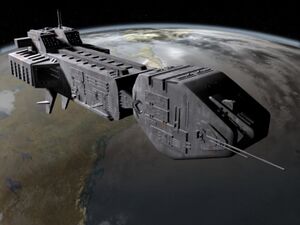| Mufrid | ||||||||||||||||||

| ||||||||||||||||||
| NZS Mufrid (JS-042) | ||||||||||||||||||
| ||||||||||||||||||
The NZS Mufrid was a short-haul interstellar troop transport operated by the Nabu–Zariin Empire. It was destroyed following a catastrophic hull failure while performing an anti-tracking manoeuvre inside the corona of NGC 9732.
Characteristics
The Mufrid was the third of the Bisāṭ-class short haul troop transports commissioned by the Nabu–Zariin Empire, with registration JS-042.
The Bisāṭ-class was designed to ferry troops on short-haul trips between star systems. It was not designed for combat on its own, and must be supported by escorts or littoral attack ships when operating in hostile areas.
Bisāṭ-class ships operate with a crew of 3:
- Commanding officer
- Pilot
- Engineer
The maximum personnel carrying complement is 206, with 200 troops in the main troop cabin, and 6 small, private rooms for officers. This means that a Bisāṭ-class transport is capable of carrying a full company, if necessary. However, with the full troop complement, the cabin is extremely cramped, so Bisāṭ-class ships normally do not transport more than a single platoon (20–50 people), especially for longer trips.
There are no facilities for long-haul trips. There is no medical bay, and Bisāṭ-class ships usually travel without a ship’s surgeon. The private quarters for the crew and officers have bunks, but there are no bunks for the personnel in the main passenger cabin. The seats in the cabin can recline when the cabin is at less than half capacity (so, less than 100 troops), but that is about all that the Bisāṭ-class offers for comfort for regular troops.
For defence, the Bisāṭ-class has only standard deflector shields. However, it has a massively reinforced hull, especially on the front end. Because of its heavily-reinforced forward hull, Bisāṭ-class transports can be surprisingly tough, when coming toward you, allowing them to plough through enemy defences to deposit their troop cargo.
The only offensive weapons Bisāṭ-class ships sport are 4 phaser turrets; 2 fore and 2 aft. The emitters are not high-powered, and share the same power bank as the deflectors, making them only marginally useful in practice.
Bisāṭ-class transports have standard impulse drives, and warp drives capable of sustained warp factor 6.1, with bursts up to 7.2 for short periods. In practice, due to their age and maintenance status, Bisāṭ-class ships rarely cruise at more than warp 5.5.
History
The Mufrid was launched on 5 May 2342, from the Imperial ship construction facility orbiting Zariin VII. It was the third of the Bisāṭ-class of short-range troop transports. The previous two Bisāṭ-class ships – the Bisat and the Shura – suffered from an imbalance in their warp fields that created stresses on the hull and frame that ultimately led to them being scuttled. The Mufrid was the first in class to correct this flaw.
Like most Nabu–Zariin military starships, the Mufrid saw effectively no combat action during its service, despite said service being alarmingly busy and long. Nabu–Zariin ships usually serve far, far past their recommended retirement date, and travel many, many more light years than engineers and maintainers think wise. The Mufrid was no exception.
Among the Bisāṭ-class, the Mufrid turned out to be one of the more sturdy and tough, and reported far fewer issues, and required far less time in dry dock undergoing maintenance, than most of her sister ships. Her reputation for hardiness earned her the nickname “The Steel Mule”.
Collision with the Astat
On 3 December 2351, Mufrid was delivering a fresh rotation of troops to the observation outpost on Nabu VIII. It was on approach to the base, when the cargo jumper Astat, rising from the surface, collided with it.
The impact was not quite head-on, but direct enough that both ships were severely damaged. The Astat suffered the worst of it, as the Mufrid’s heavy forward armour tore down the starboard ventral side of the ship.
Luckily for the Mufrid, all of the cargo containers were empty, as the Astat had just finished its delivery run to the Nabu VIII outpost. The containers crumpled, absorbing the bulk of the energy of the impact. One cargo officer of the Astat was in one of the containers, and was killed instantly.
The deflector shields of the Mufrid failed, but the strong forward armour mostly held. The cockpit was breached, and both the commanding officer, Binbaşı Toral Narek, and the pilot, Yüzbaşı Shamar Tuul, were ejected into space in the explosive decompression.
In the rear of the Mufrid, engineer Yüzbaşı Alanya Subanalyi was thrown against a console she was working on, suffering a broken humerus and dislocated shoulder. Despite that, she managed to maintain consciousness, and take emergency control of the ship from the main engineering console. She was able to prevent the ship from crashing into the outpost, and attain a stable orbit. For this, she received a commendation, and promotion to the rank of binbaşı.
The Astat suffered catastrophic damage. Almost the entirety of its starboard ventral side was torn away, and the ship was actually bent at a 5° angle along its length. It had to be decommissioned following the incident. Despite this, there was only a single casualty – a cargo engineer who happened to be in one of the containers crushed by the impact. The rest of the crew was either working in the port side, or in the command and engineering sections on the dorsal and aft areas of the ship.
The Mufrid suffered only 3 casualties: the commanding officer, the pilot, and one trooper who suffered a traumatic skull fracture when he was thrown against a bulkhead. Of the passenger complement of 2 officers and 20 troopers, there were only 8 serious injuries, all among the troopers in the main cabin, mostly broken bones. The Mufrid itself suffered significant denting and buckling of its forward armour, and a breach of the cockpit. Even after repairs were made, many people claimed to still be able to see the massive dent in the starboard side of the ship’s front end.
The crew of the Astat was found responsible for the accident, for launching at the incorrect angle, and failing to report the deviation from their flight path. All 7 surviving crew members were enslaved.
The Princess’s royal yacht
By 2375, the Mufrid had already had a long and honourable service, and though long past its recommended decommissioning date, was still operating reliably and without issue.
In that year, the Stone Princess, Suurya ibn Maktaar of Zariin, decided to take a more active political role, and expand her influence beyond Zariin V. For this, she needed a royal transport. She commissioned one to be built, but was quickly frustrated by unexpected costs and delays. Rather than wait out the process, she decided to perform a bit of political theatre, and show the citizens of the Empire that she was “one of them”. She selected the Mufrid for its long service history, and reputation for durability, and because the Bisāṭ class was known for its rugged, spartan, and austere travelling conditions.
The troop cabin of the Mufrid was heavily modified to transform it into a giant cabin suitable for a princess, and for around 3 months, whenever Suurya ibn Maktaar travelled, she did so in her personal chariot: the Mufrid.
When her royal yacht was finally completed, Suurya ibn Maktaar transferred her flag there, and the Mufrid was restored to its operational configuration. Publicly, Princess Suurya always spoke fondly of her travels in the Mufrid, praising it as a hardy and dependable ship, one of the rocks the Empire is built on. However, there are rumours that she privately described the Mufrid as a “rattle-trap” that was “held together by baling wire and prayer”, and that it had only lasted as long as it had because “the Steel Mule was too stubborn even to die when it should have”.
Crews operating the Mufrid since have taken both her public and alleged private statements with pride. Indeed, the words “TOO STUBBORN TO DIE!” were scrawled across the forward hull.
Final mission and sinking
In 2379, the Mufrid was hastily assigned a top secret transport mission as part of Operation Tulu. No information was given to the crew what the nature of the mission was, or even their destination. The crew was simply told they would be carrying a complement of 4 officers and up to 50 troopers, and that they would be informed of their destination en route.
The crew consisted of:
- Commanding officer
- Binbaşı Abbas Rasaei
- Pilot
- Yüzbaşı Jamshid Zandi
- Engineer
- Yüzbaşı Elham Jarrahi
The Mufrid landed on Zariin V, and waited at the spaceport, with the crew sequestered in the ship, for almost a day before the passengers arrived. The passenger roster at launch was:
- 4 officers
- 23 troopers
The Mufrid launched on 15 February 2379.
Standard Nabu–Zariin practice for military operations is to perform journeys in 7 phases. Each phase (except the last) ends by diving into the corona of a star, to mask the ion trail of the ship, and thus make it functionally impossible to follow between warps. This practice is not uncommon among other armed forces, though few do more than 3 phases, as there are diminishing returns for each extra step, and increasing risk.
Shortly after takeoff, Tümamiral Volath Gura informed Binbaşı Rasaei that he wanted 3 times as many phases in this journey, for a total of 20 coronal dives. Binbaşı Rasaei did not log a formal objection to this command, though both he and Yüzbaşı Zandi noted in their personal logs that this excessive “security” would be pointless and unnecessarily dangerous. It would also increase the travel time by almost 8 days, for a total of 12 days, which would be increasingly unpleasant for the troopers in the main cabin.
A week of travel time passed mostly uneventfully. On 22 February 2379, the Mufrid entered the system of star NGC 9732 for its 15th coronal dive.
At around 1700 hours, Binbaşı Rasaei and Yüzbaşı Zandi were in the cockpit, performing the coronal dive manoeuvre. Yüzbaşı Elham Jarrahi was in the engineering section, monitoring the deflectors. Binbaşı Surran Joshal, Binbaşı Kuras, and Astsubay üstçavuş Saya Sabanalyi were in the main cabin, overseeing the 21 troopers present. Er Zayba Salnalyi had retreated to the head, to avoid unwanted advances by Tümamiral Gura. Er Haranh Sutkalyi was in Gura’s quarters with the Tümamiral, either unable to resist his advances, or willingly submitting to them.
At 1703 hours, while deep in the corona of NGC 9732, the port dorsal hull over the main crew cabin failed, and a 15 m² section tore away. This caused a violent explosive decompression of the main cabin. All 24 people who were in the cabin are presumed to have been blown out into space immediately.
The blast of decompressing air shoved the ship starboard uncontrollably, overwhelming the inertial dampeners. All crew members who had not been blown out into space were thrown violently against the walls, consoles, and bulkheads. Commanding officer Rasaei suffered multiple bone and spinal fractures, and likely lost consciousness instantly. Pilot Zandi was partially strapped into the helm seat, and suffered a broken spine, but managed to retain consciousness for at least a few seconds, long enough to attempt to get to one of the emergency suits, though he did not make it. At least one of Tümamiral Gura and Er Sutkalyi survived this initial lurch long enough to get to the door of Gura’s quarters and open it… unfortunately, opening the private cabin to the main cabin, which was in the process of explosively decompressing. Both Gura and Sutkalyi were sucked into space.
The sudden pressure shock from the decompression caused the ventilation system to collapse, so that even areas that were not directly exposed to space began to decompress, and eventually, flood with coronal plasma. Engineer Jarrahi, who had survived the initial lurch with only bruises, managed to get into her emergency suit. However, the suit was so old and poorly maintained that the seals had dried out, and failed. Jarrahi suffocated while trying to remove the suit to change to another.

Er Zayba Salnalyi was the only survivor of the catastrophe, though not directly. When the ship initially lurched port-ward, she was thrown violently against the walls of the head, and lost consciousness. The head, like the rest of the ship, decompressed, and then filled up with radioactive coronal plasma. However, because the head remained enclosed, Salnalyi was the only passenger of the Mufrid who was not blown into space. (The three crew members were also not blown into space; Rasaei’s and Zandi’s bodies remained in the cockpit, and Jarrahi’s in the engineering section. However, the bodies of all other passengers, both officer and trooper, were ejected during the incident.)
All systems on the Mufrid failed and shut down within minutes of the breach, but the ship continued on its path under inertia, adopting a highly elliptical orbit around the star. It remained in the corona for around two weeks, and would have reached its apocentre around 7 million kilometres away after another 8 weeks, after which it would have fallen back into the star, this time fatally.
Discovery of the wreck
After 4 weeks, the Mufrid was officially reported as lost by the Nabu–Zariin Empire. Curiously, the Empire reported the ship as destroyed, not missing, even though it had no idea of the ship’s fate. This seems to have been an effort to avoid questions. (A ship being destroyed was not uncommon in Nabu–Zariin, with their aged and poorly maintained fleet. Recording the ship as “missing” leaves its case file open, whereas recording it as “destroyed” closes any further inquiry.)
On 8 April 2379, the Solas Tempus Aerowing shuttle Creon (attached to the USS Ismene) navigated close enough to NGC 9732 that Commander Edward Cardon was able to detect the wreck of the Mufrid. By this point, the Mufrid had drifted out of the star’s corona, and was not yet at the apocentre of an orbit that would eventually have it fall into the star.
After initial scans showed the ship to be lifeless and dead in space, Cardon consulted his superiors. Solas Tempus was aware that the Mufrid had been involved in some ultra-top-secret project called “Operation Tulu”, but they had no clue what that operation was. The amount of secrecy surrounding it piqued their interest however, and Cardon’s discovery of the wreck provided a golden opportunity to investigate.

Cardon claimed legal salvage rights over the Mufrid, and proceeded to extend the Creon’s shields over the hull breach, so that life support could be restored. It took several minutes to restore a breathable atmosphere, and for the temperature gradients to normalize, then he beamed over with the intention of investigating the ship, and downloading its computer data.
Minutes after he beamed over, Cardon was alerted that a new life sign had appeared. This was both impossible, and infuriating. It was impossible because the only people who were supposed to be on the Mufrid were human, and no human could survive even a few minutes of the conditions that the Mufrid endured for weeks. It was infuriating because if there were a survivor, then his legal claim of salvage was void; this was no longer a salvage mission, it was a rescue mission.
Although the life sign could potentially be a sensor anomaly, Cardon was obligated to investigate it. However, when he tried to approach, he was attacked by Er Zayba Salnalyi.
Salnalyi had regained consciousness only moments earlier. She had no idea that weeks had passed, and assumed she had only been unconscious for a short time. However, she recognized that the ship was massively damaged, and assumed it had been attacked. She heard Cardon approaching, and figured he was part of a follow-up boarding party from those who had attacked the ship.
After some back and forth, Cardon begrudging agreed to return Salnalyi to the Nabu–Zariin Empire, and he abandoned his investigation of the ship.
A week later, a second Solas Tempus ship, this time from Green Team, arrived to attempt a second legal salvage. They studied the wreckage, the computer files, and the corpses of the crew, but found no useful information about Operation Tulu.
Once it was clear there was nothing further to be gained from it, the derelict Mufrid was allowed to continue its final orbit, and eventually burn up in the star.